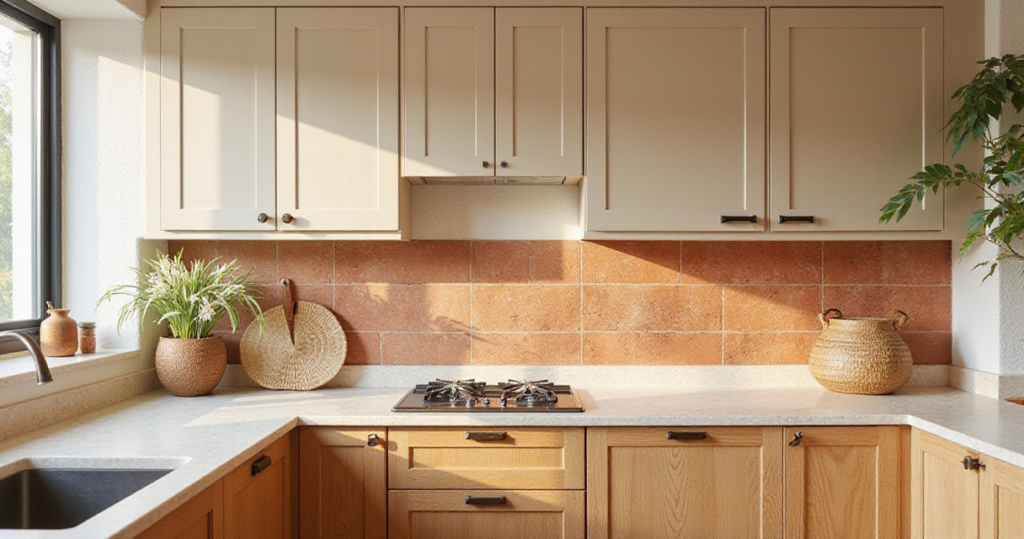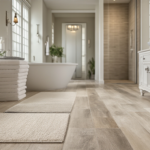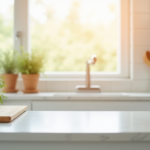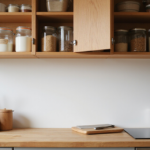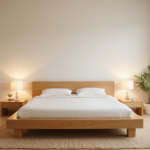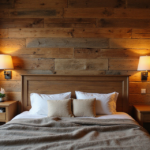Creating an eclectic kitchen bohemian space means embracing the unexpected while honoring your personal story through design. This isn’t about following rigid rules or achieving Instagram perfection—it’s about layering textures, colors, and meaningful objects to craft a kitchen that feels authentically yours. When working with smaller spaces, this approach becomes even more powerful, as every carefully chosen element serves multiple purposes while contributing to the overall narrative.
The beauty of bohemian design lies in its celebration of imperfection and its ability to make even the most compact kitchen feel expansive through thoughtful curation. By blending global influences with practical storage solutions and multi-functional pieces, you can transform your culinary space into a vibrant hub that reflects your adventures, creativity, and love for handcrafted beauty. These 24 ideas will help you maximize every square inch while creating a kitchen that tells your unique story.
1. Layer Warm Earth Tones for Instant Comfort
The foundation of any successful eclectic kitchen bohemian design starts with a carefully curated palette of warm earth tones. Think beyond basic beige—consider the rich terracotta of Moroccan pottery, the deep sage of desert plants, or the warm ochre found in ancient cave paintings. These colors work together to create an immediate sense of grounding and comfort, making even the smallest kitchen feel like a cozy retreat rather than just a functional workspace.
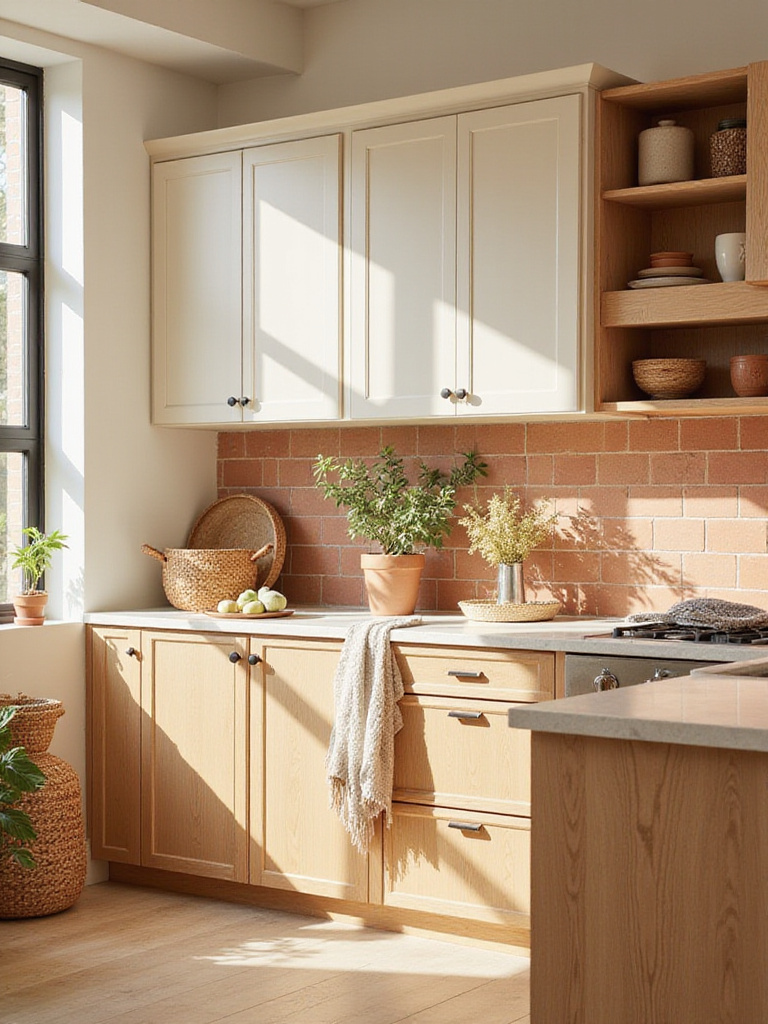
In compact spaces, these earthy hues serve double duty by creating visual continuity that makes the room feel larger while providing a neutral backdrop for your collected treasures. Start with one dominant earth tone for larger surfaces like walls or cabinets, then layer in 2-3 complementary shades through accessories, textiles, and smaller furniture pieces. The key is building depth gradually—a sage green backsplash might pair beautifully with warm cream cabinets and rust-colored pottery displayed on open shelving.
What makes this approach particularly effective for small kitchens is how these colors naturally recede, creating the illusion of expanded space while maintaining that essential bohemian warmth.
2. Mix Textures Through Natural Materials
Creating visual interest in a compact eclectic kitchen bohemian space requires strategic layering of diverse textures that engage multiple senses. Combine the rough warmth of jute placemats with the smooth coolness of ceramic tiles, or pair the organic irregularity of handwoven baskets with the sleek surface of a marble countertop. This textural diversity prevents small spaces from feeling flat or monotonous while adding the tactile richness that defines authentic bohemian style.
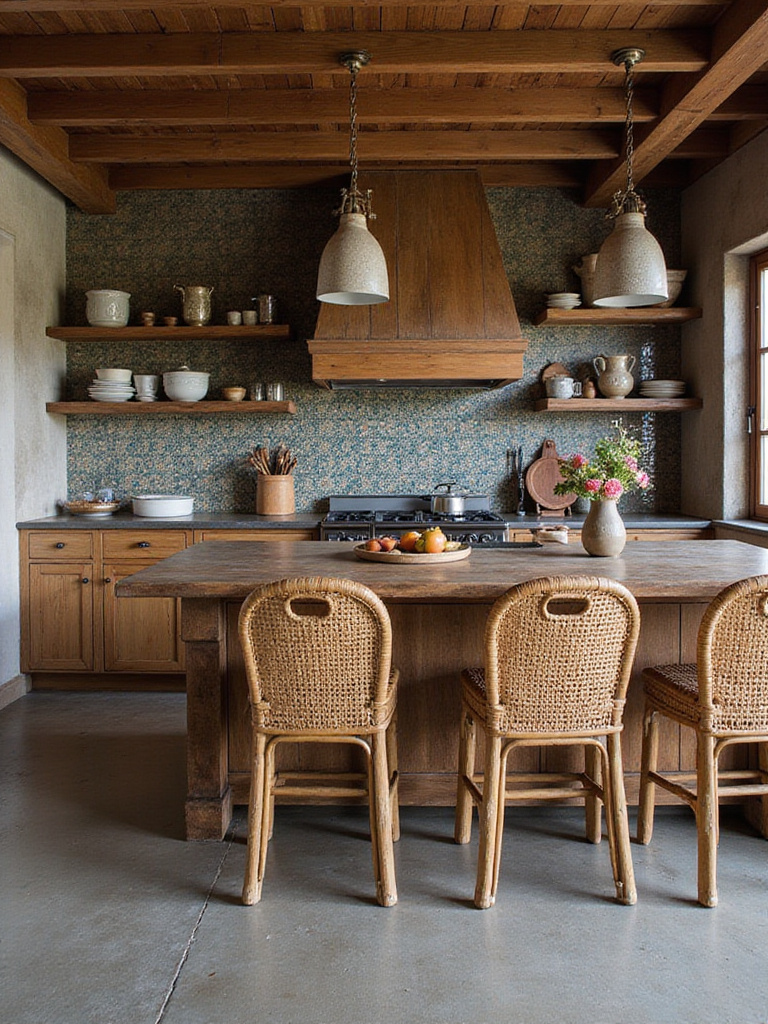
The secret lies in balancing hard and soft elements throughout the space. Consider these effective combinations:
- Rough-hewn wooden cutting boards displayed against smooth subway tiles
- Woven rattan pendant lights above polished concrete counters
- Nubby linen tea towels draped over glossy ceramic vessels
- Hammered copper hardware on matte-painted cabinet doors
This layering technique works especially well in smaller kitchens because it creates visual depth without requiring additional square footage—every surface becomes an opportunity to add another textural element that contributes to the overall bohemian narrative.
3. Embrace Vintage Finds for Character
Scouring flea markets and estate sales for unique pieces is one of the most rewarding aspects of creating an eclectic kitchen bohemian aesthetic. These pre-loved treasures bring instant character and history to your space while often providing better value than mass-produced alternatives. A vintage brass scale might serve as both functional tool and sculptural element, while antique wooden spoons displayed in a ceramic crock add warmth and authenticity that new items simply cannot replicate.
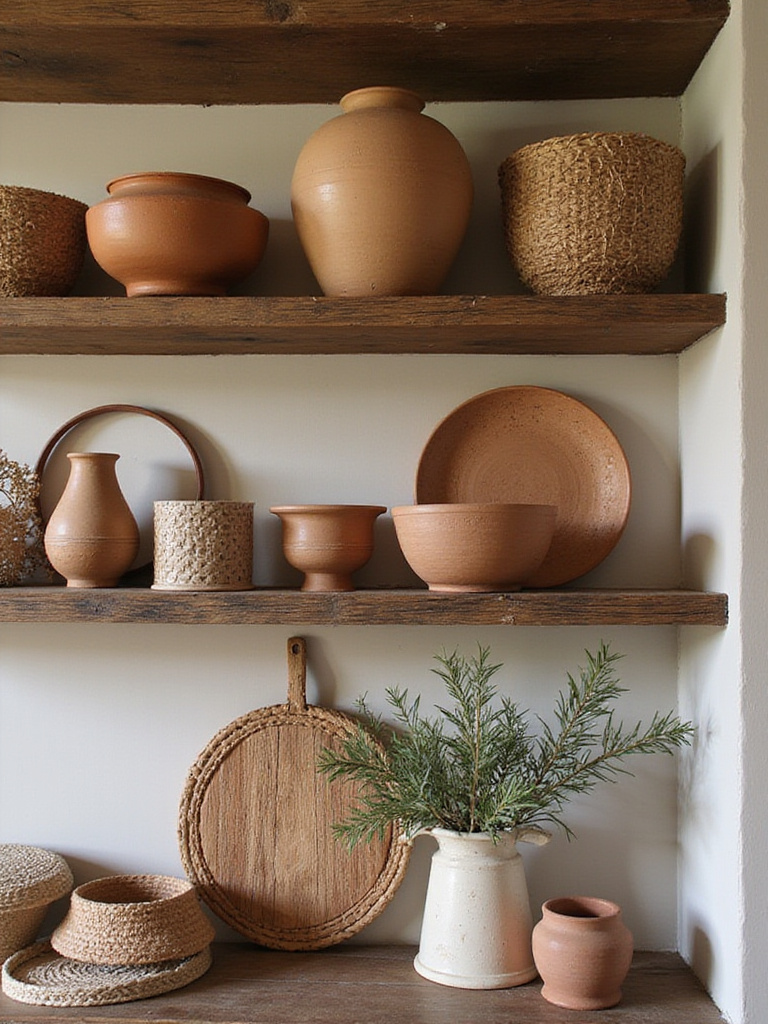
The key to successfully incorporating vintage finds in a small kitchen is choosing pieces that serve multiple purposes. An old wooden ladder can become a pot rack, while vintage mason jars provide both storage and visual appeal when filled with colorful spices or dried beans. Look for items with interesting patinas, unique proportions, or craftsmanship details that tell a story—these imperfections and variations are what give bohemian spaces their soul and prevent them from feeling sterile or overly coordinated.
The magic of this collection begins with a conversation about renewal that went beyond the expected pastels and florals.
4. Create Open Storage Displays
Transforming necessary storage into decorative displays is crucial for maximizing both function and style in an eclectic kitchen bohemian space. Open shelving allows you to showcase your most beautiful dishes, glassware, and serving pieces while keeping them easily accessible for daily use. This approach works particularly well in smaller kitchens where every item needs to earn its place through both utility and aesthetic appeal.
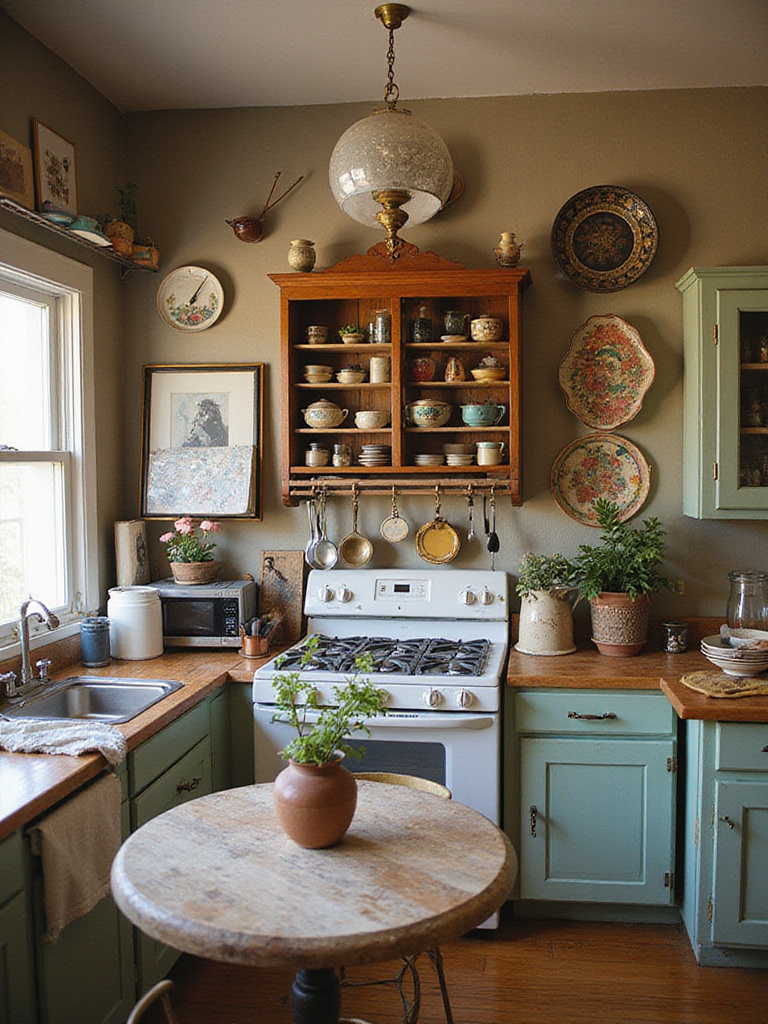
Arrange your open displays with the same care you’d give to a gallery wall—group items by color, material, or theme to create visual cohesion while maintaining the eclectic spirit. Stack vintage plates of varying sizes, nestle small potted herbs between ceramic bowls, and lean cutting boards against the wall to add vertical interest. The goal is creating vignettes that feel collected over time rather than purchased all at once.
- Mix heights and shapes for dynamic visual rhythm
- Leave breathing room between groupings to avoid clutter
- Rotate seasonal items to keep displays fresh and engaging
- Include both functional pieces and purely decorative objects
Beyond the obvious placement, consider using this technique to transform awkward corners into charming storage nooks that contribute to your kitchen’s overall bohemian character.
5. Install Statement Lighting Fixtures
Lighting in an eclectic kitchen bohemian space should feel like jewelry for your room—unexpected, beautiful, and deeply personal. Instead of settling for standard pendant lights, seek out fixtures that tell a story: perhaps a vintage Moroccan lantern above your dining area, or a collection of woven rattan shades at varying heights over your kitchen island. These unique pieces become instant conversation starters while providing the warm, layered illumination that makes small spaces feel intimate rather than cramped.
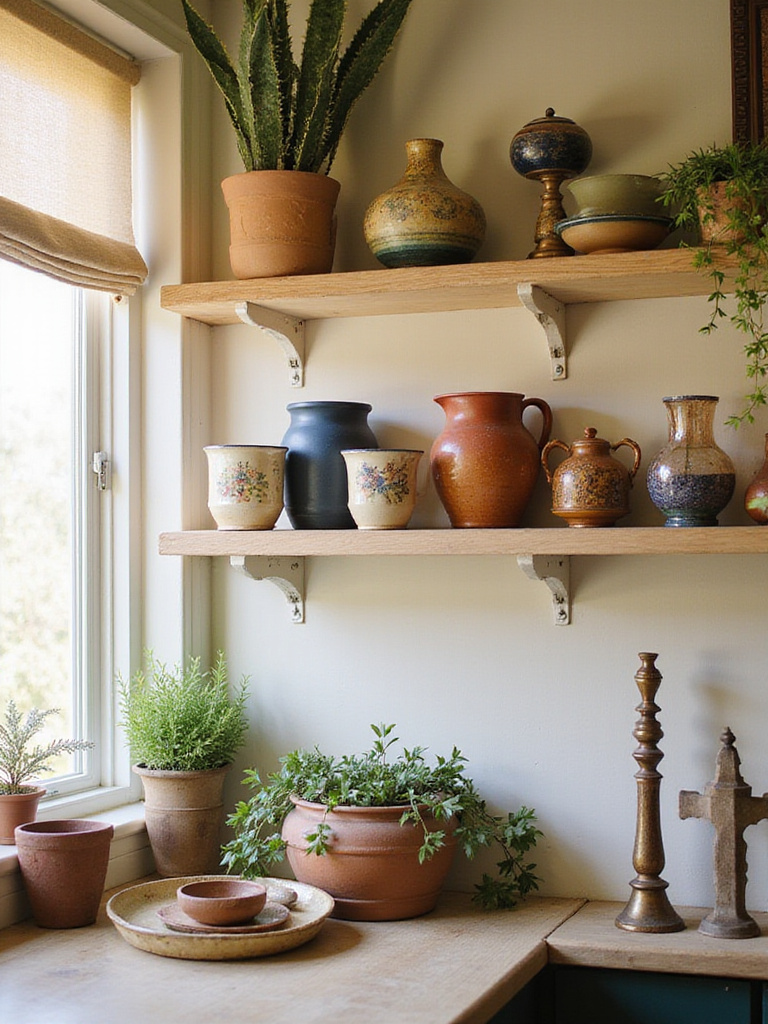
The key to successful bohemian lighting is mixing different styles, materials, and eras within the same space. A mid-century brass pendant might hang alongside a macramé-wrapped Edison bulb fixture, unified by warm metal accents or similar bulb choices. This eclectic approach prevents your kitchen from feeling too themed while ensuring adequate task lighting for cooking and food preparation.
Consider these unconventional lighting solutions for small spaces:
- String lights woven through open shelving for ambient glow
- Vintage table lamps on counters for cozy task lighting
- Candle lanterns grouped on floating shelves
- Under-cabinet strips hidden behind decorative trim
Running your hand across this material reveals how dramatically lighting can transform the mood of your space from bright and energetic during meal prep to soft and contemplative during evening conversations.
6. Incorporate Living Plants Strategically
Plants are essential for achieving an authentic eclectic kitchen bohemian atmosphere, but in smaller spaces, every green addition must be carefully considered for both aesthetic impact and practical maintenance. Focus on varieties that thrive in kitchen conditions—herbs like basil and mint provide both beauty and culinary function, while trailing pothos can soften hard edges when cascaded from high shelves or mounted planters.
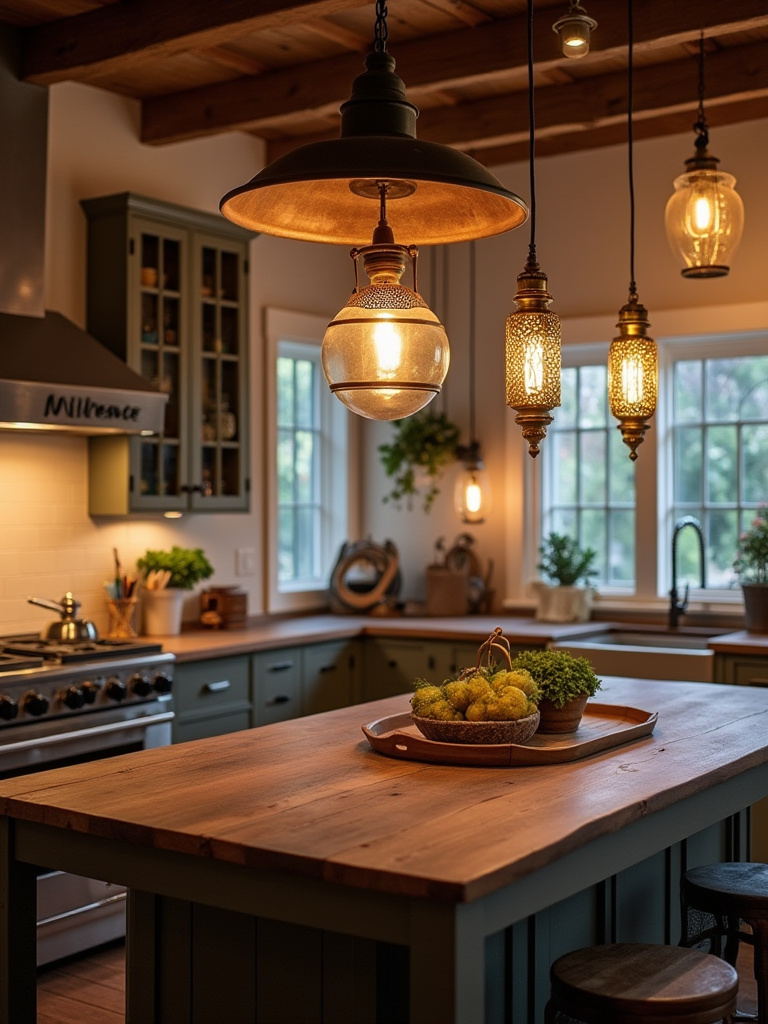
Vertical growing solutions maximize your plant collection without sacrificing precious counter space. Wall-mounted planters, hanging baskets, and tiered plant stands draw the eye upward, making your kitchen feel taller and more spacious. Choose containers that reinforce your bohemian aesthetic: weathered terracotta pots, woven baskets with plastic liners, or vintage ceramic vessels repurposed as planters.
The key is creating layers of greenery at different heights throughout the space. A large floor plant in one corner might anchor the room, while smaller herbs on the windowsill provide daily interaction, and trailing plants from upper shelves add movement and softness to the overall composition.
Look closely and you’ll notice the subtle texture these living elements add to your kitchen’s visual and aromatic landscape.
7. Design a Gallery Wall with Global Art
A thoughtfully curated gallery wall transforms blank kitchen walls into a celebration of your travels, interests, and artistic sensibilities. In an eclectic kitchen bohemian space, this collection should feel organic and personal rather than perfectly matched—combine framed photographs from your adventures with small textile pieces, vintage postcards, and perhaps a few three-dimensional objects like small masks or carved wooden pieces mounted on shadow boxes.
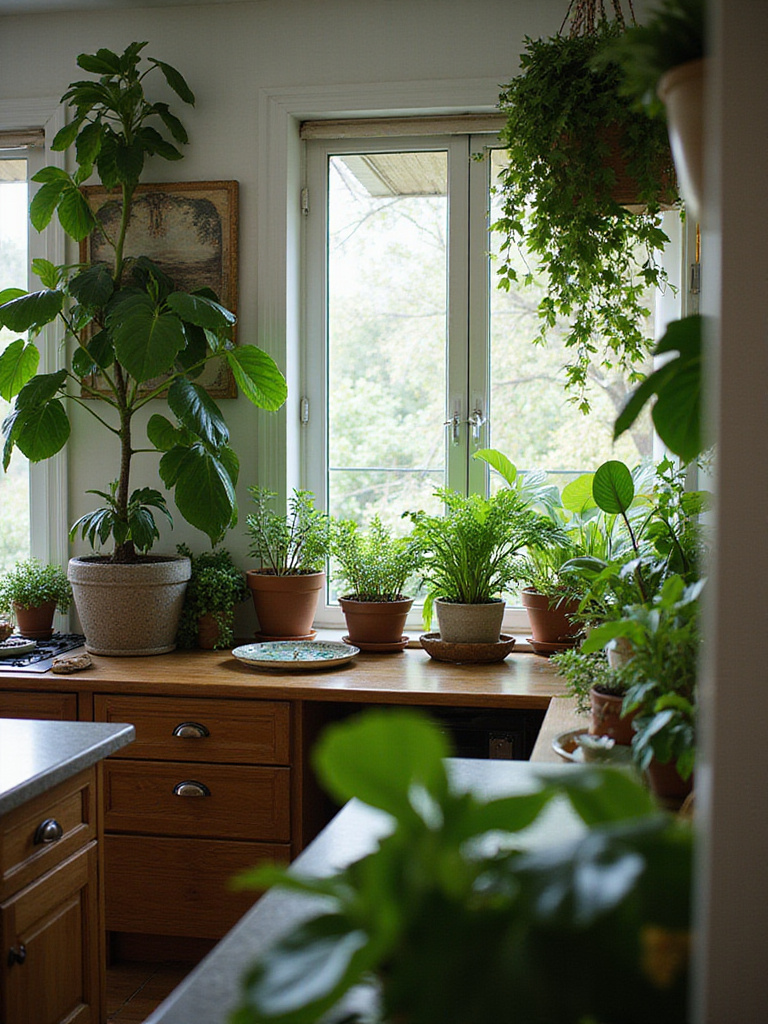
The beauty of a kitchen gallery wall lies in its ability to evolve with your life and travels. Start with a few anchor pieces and add to the collection gradually, allowing the display to grow and change as you discover new treasures. This approach feels more authentic than trying to complete the entire wall at once and ensures that every piece has genuine meaning for you.
- Mix frame styles and finishes for authentic eclectic appeal
- Include unexpected elements like small shelves with tiny objects
- Vary the scale from large statement pieces to intimate details
- Leave room for future additions as your collection grows
What makes this design special is the way it transforms a purely functional space into a reflection of your personal journey and aesthetic evolution.
8. Layer Textiles for Warmth and Pattern
Textiles are the secret weapon for adding instant bohemian character to any kitchen, especially smaller spaces where major architectural changes aren’t feasible. Layer different patterns, textures, and cultural influences through tea towels, table runners, window treatments, and even small area rugs. The key is finding a common thread—perhaps a shared color palette or similar level of intensity—that allows diverse patterns to coexist harmoniously.

In compact kitchens, textiles serve multiple functions beyond pure decoration. A beautiful vintage tablecloth can protect your dining surface while adding color and pattern. Linen tea towels in complementary prints provide both function and style when hung from hooks or draped over baskets. Window treatments in global-inspired patterns add privacy while filtering light beautifully throughout the day.
Start with one bold pattern as your anchor—perhaps a vibrant ikat table runner—then layer in smaller prints and solids that echo its colors. This approach prevents pattern overload while ensuring your space feels rich and collected rather than sparse or sterile.
The interplay between the colors creates a sense of warmth and global sophistication that’s fundamental to authentic bohemian style.
9. Repurpose Furniture for Kitchen Function
One of the most effective ways to achieve an eclectic kitchen bohemian aesthetic while maximizing functionality is repurposing furniture pieces never intended for kitchen use. An antique dresser can become a unique kitchen island with the addition of a butcher block top, while a vintage bookshelf might serve as open pantry storage or display space for your collection of ceramic bowls and serving pieces.
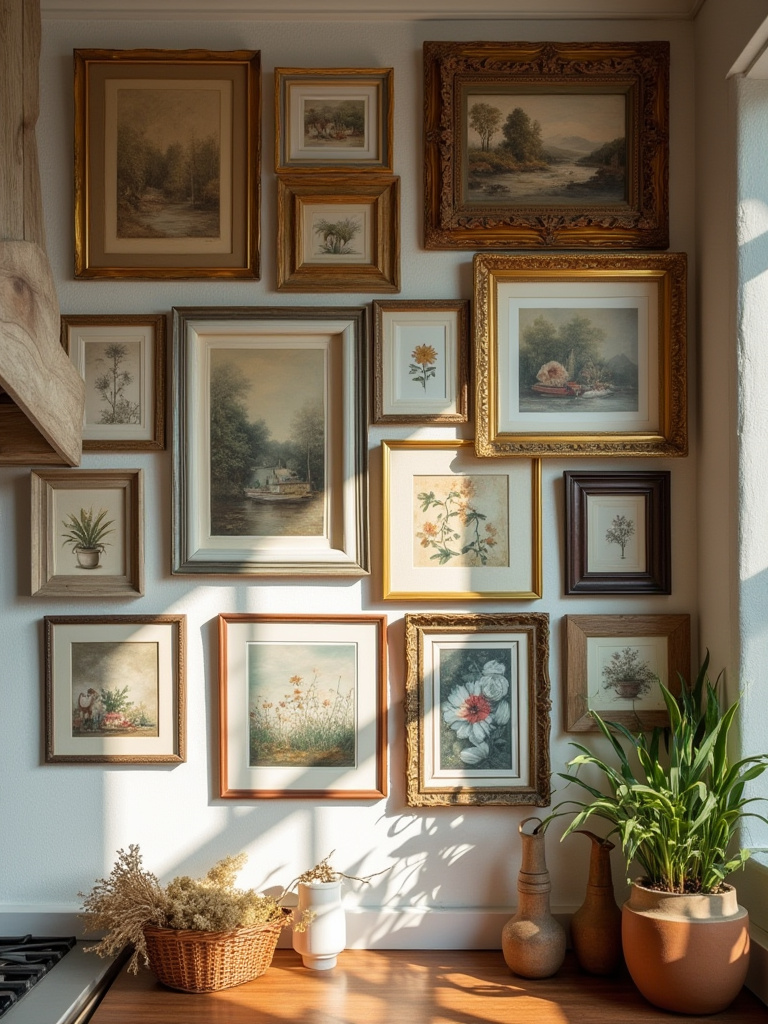
This approach works particularly well in smaller kitchens where standard cabinetry might feel too bulky or uniform. Look for pieces with interesting proportions, unique hardware, or beautiful wood grain that adds character to your space. The key is ensuring any repurposed piece can withstand kitchen conditions—you may need to add protective finishes or modify drawers to accommodate kitchen tools and supplies.
Consider these creative repurposing ideas:
- Vintage suitcases stacked as a side table with hidden storage
- An old ladder repurposed as a pot rack or herb garden display
- Antique wooden crates mounted as open shelving
- A small vintage table converted to a coffee or tea station
The unexpected pairing that always works is combining these unique furniture pieces with more traditional kitchen elements to create visual interest and functional efficiency.
10. Display Collections with Purpose
Every eclectic kitchen bohemian space needs collections that reflect the owner’s passions and travels, but in smaller kitchens, these displays must be both beautiful and functional. Whether it’s vintage teacups, colorful ceramic bowls, or handcrafted wooden spoons, arrange your collections thoughtfully to create visual impact while maintaining easy access for daily use.
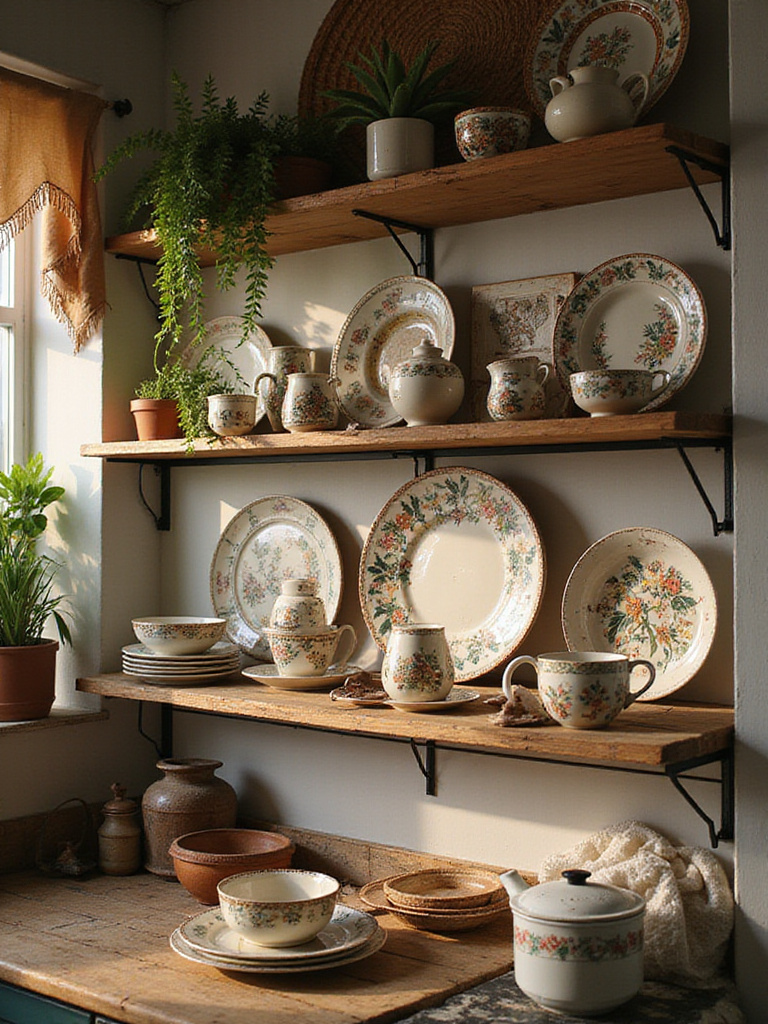
The secret to successful collection display is creating groupings that feel intentional rather than cluttered. Use the rule of odd numbers—groups of three or five items often feel more natural than even-numbered arrangements. Vary heights within each grouping and leave breathing room between different collections to prevent visual overwhelm in your compact space.
Think about how natural light interacts with your displayed items throughout the day. Glassware catches morning light beautifully when placed on east-facing shelves, while ceramic pieces might glow warmly in afternoon sun. This consideration adds another layer of visual interest as your collections change appearance with the shifting light.
Unlike single-purpose decor, this approach adapts to your evolving collection while maintaining the curated, well-traveled aesthetic essential to bohemian style.
11. Choose Unique Hardware and Fixtures
The details make all the difference in achieving an authentic eclectic kitchen bohemian look, and hardware selections offer an opportunity to inject personality into even the most basic cabinetry. Instead of matching sets, mix different styles, finishes, and even eras—perhaps combining vintage brass pulls with handcrafted ceramic knobs or leather-wrapped handles that add unexpected texture and warmth.
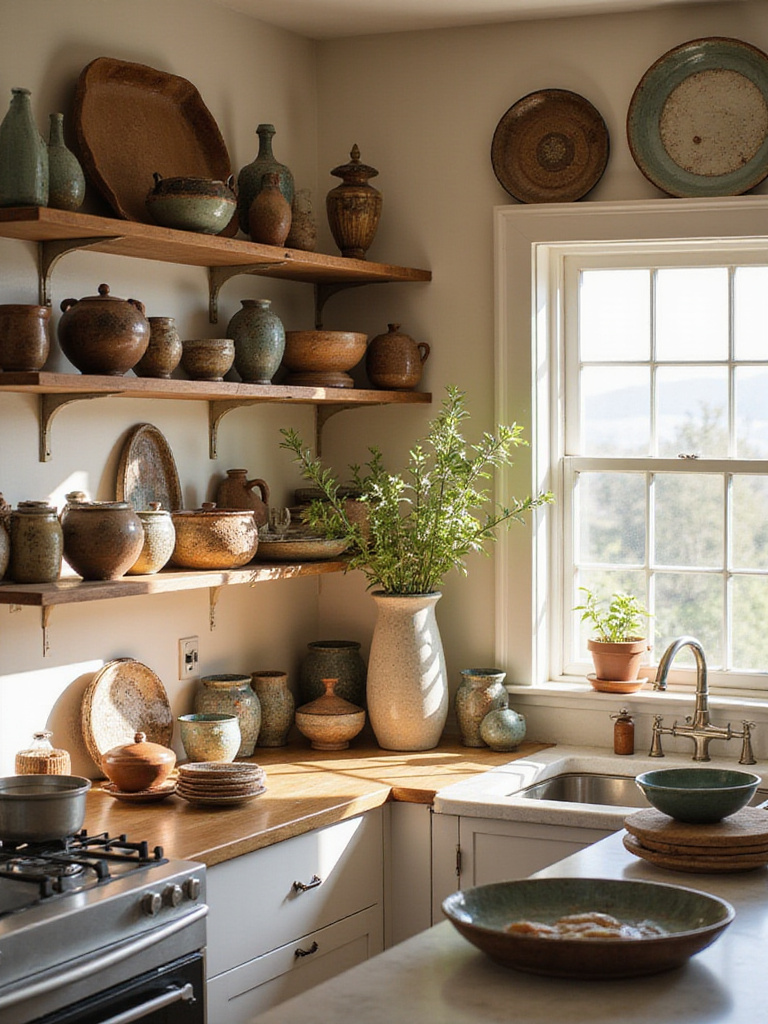
Your faucet becomes a sculptural element that can anchor your entire design scheme. Look for pieces with interesting proportions, unique finishes, or artisanal details that feel more like art than standard plumbing fixtures. Unlacquered brass develops a beautiful patina over time, while copper fixtures add warmth and develop their own unique character through daily use.
Don’t limit yourself to traditional kitchen hardware sources. Antique shops, artisan markets, and even online platforms offer unique options that can transform standard cabinets into something truly special. The key is ensuring all your choices work together tonally, even if they don’t match exactly.
The craftsmanship reveals itself in details like hand-forged metal work and the subtle variations that only come from artisanal production methods.
12. Create Cozy Seating Areas
Even the smallest eclectic kitchen bohemian space can accommodate a cozy seating area that transforms your kitchen from purely functional to genuinely livable. This might be as simple as a small bench tucked under a window with colorful cushions, or a pair of vintage stools that can slide under your island when not in use. The goal is creating a spot where someone can sit with a cup of coffee, help with meal prep, or simply enjoy the atmosphere you’ve created.
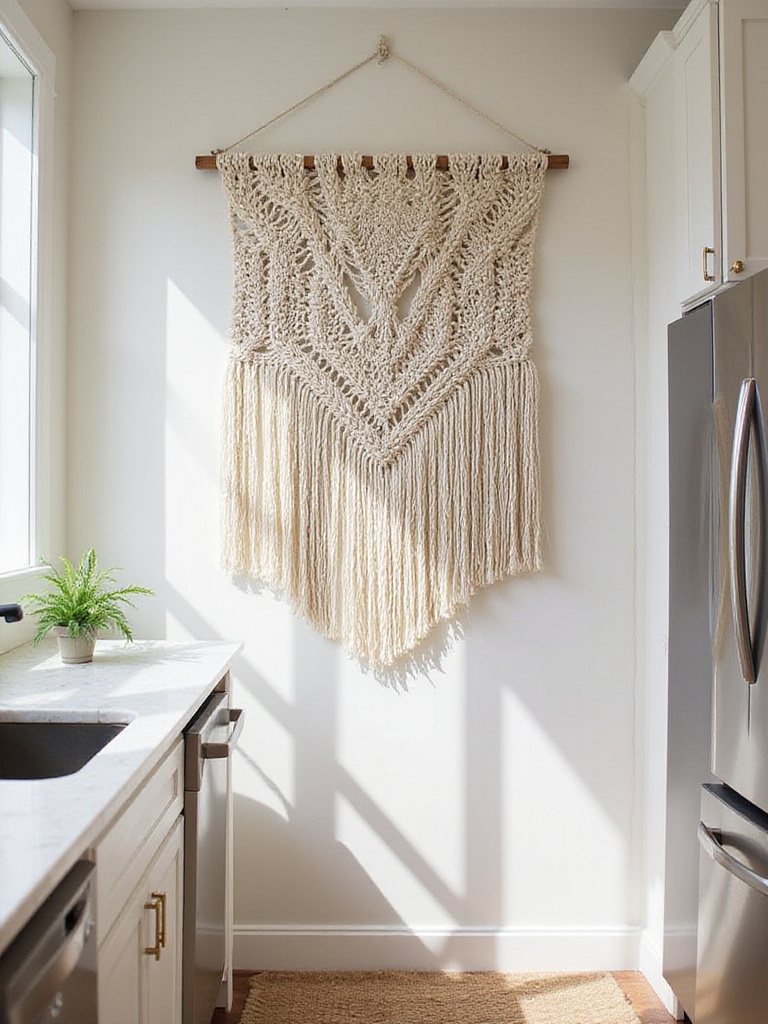
Floor cushions offer maximum flexibility in tight spaces—they can be stacked when not needed and arranged in different configurations depending on your needs. Choose fabrics that can withstand kitchen conditions while adding the rich textures and global patterns that define bohemian style. Vintage kilim rugs make excellent oversized floor cushions when properly stuffed and sewn.
The key is making these seating areas feel intentional rather than afterthought. Add a small side table for drinks, ensure adequate lighting for reading or conversation, and include storage solutions like baskets underneath benches for extra linens or seasonal items.
Picture the warmth of evening conversations around these thoughtfully created gathering spots that make your kitchen the heart of your home.
13. Incorporate Handmade Ceramics and Pottery
Handmade ceramics and pottery are fundamental to achieving an authentic eclectic kitchen bohemian aesthetic, bringing the irregularities and character marks that mass-produced items simply cannot replicate. These pieces tell stories—of the potter’s hands, the firing process, the cultural traditions they represent—and add soul to your kitchen in ways that perfectly uniform dishes never could.
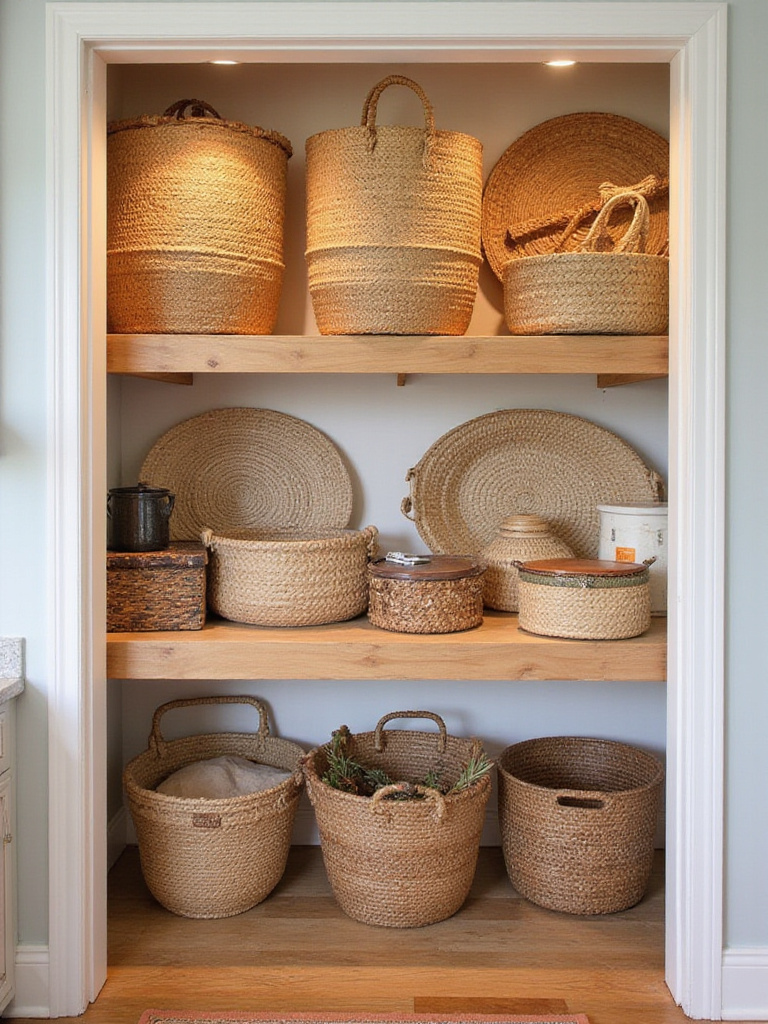
Build your collection gradually, mixing different cultural traditions, clay types, and firing techniques. Japanese raku pieces might sit alongside Mexican Talavera pottery and local artisan bowls, unified by their handmade quality rather than matching patterns. This approach creates visual richness while supporting craftspeople and maintaining the global, well-traveled feeling essential to bohemian design.
Use these pieces both functionally and decoratively—a beautiful handmade bowl might hold fruit on your counter during the day and serve salad at dinner. This dual purpose maximizes the impact of each piece while ensuring your collections feel lived-in rather than museum-like.
The environmental story behind this piece began with clay sourced from local deposits and shaped by techniques passed down through generations of artisans.
14. Add Aromatic Elements Naturally
Scent plays a crucial role in creating the full sensory experience of an eclectic kitchen bohemian space, but the approach should feel natural and integrated rather than artificially imposed. Fresh herbs growing on windowsills provide both visual beauty and natural fragrance when you brush against them during cooking. Dried flowers and grasses arranged in vintage vessels add texture while releasing subtle, natural scents.
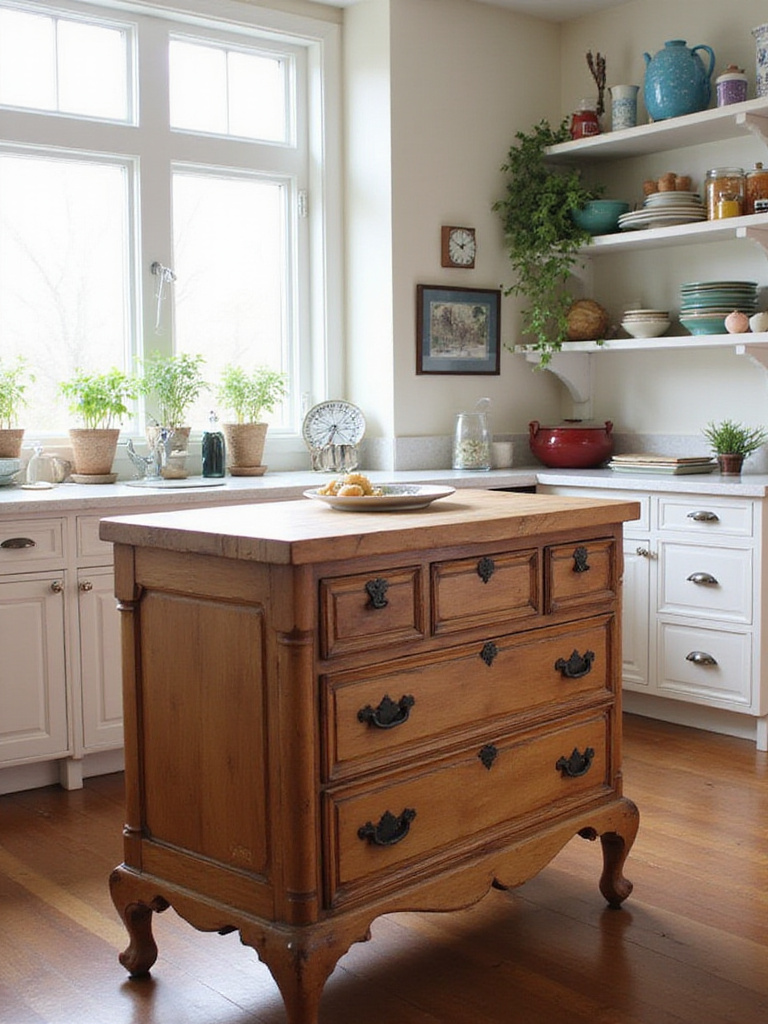
Consider keeping a small pot of simmering spices on the stove during gatherings—cinnamon sticks, cardamom pods, and orange peels create an inviting aroma that feels organic to the kitchen environment. Essential oil diffusers can work well if you choose earthy, natural scents that complement rather than compete with cooking aromas.
The goal is creating a layered scent experience that changes throughout the day and seasons, much like the visual elements of your bohemian design. Morning might bring the fresh scent of herbs, afternoon the warm spices of cooking, and evening the gentle fragrance of dried lavender or eucalyptus.
The subtle fragrance fills the room while connecting you more deeply to the natural elements that define authentic bohemian living.
15. Design Functional Art Displays
In an eclectic kitchen bohemian space, the line between functional items and art should blur beautifully. Your most gorgeous cutting boards become wall sculptures when not in use, while vintage copper pots transform into a stunning display that’s also completely practical. This approach maximizes visual impact in small spaces while ensuring every beautiful object serves a purpose.

Create dedicated display areas that can transition between storage and exhibition. A vintage plate rack might hold your everyday dishes while creating an attractive wall feature. Magnetic knife strips become functional art when you choose versions in interesting materials like wood or stone, and arrange your knives by size and style for visual appeal.
The key is choosing items beautiful enough to display proudly while ensuring they remain easily accessible for daily use. This philosophy prevents your kitchen from feeling precious or untouchable while maintaining the curated, collected aesthetic that defines bohemian style.
- Hang beautiful cutting boards in varying sizes and wood types
- Display vintage kitchen tools as sculptural elements
- Use glass jars filled with colorful spices as decorative storage
- Arrange copper pots and pans as a warm metallic accent wall
The composition comes together when you treat everyday objects with the same care and attention you’d give to precious artwork.
16. Layer Lighting for Ambiance
Creating the perfect lighting scheme for your eclectic kitchen bohemian space requires thinking beyond basic overhead fixtures to build layers of illumination that can adapt to different moods and activities. Combine task lighting for food preparation with ambient lighting for dining and accent lighting to highlight your favorite collections and architectural features.
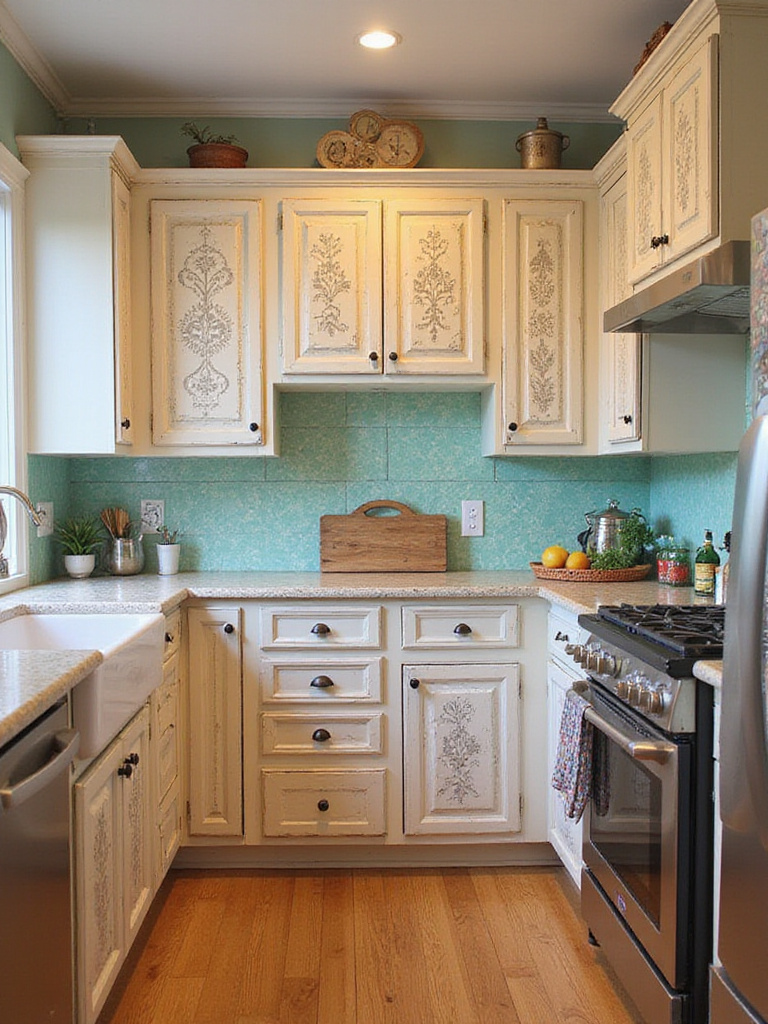
String lights aren’t just for outdoor spaces—when thoughtfully incorporated, they add magical warmth to kitchen areas. Weave them through open shelving, around window frames, or above seating areas to create a soft glow that makes evening meals feel special. Battery-operated versions offer flexibility in placement without requiring electrical work.
Candles and lanterns provide the ultimate bohemian ambiance while offering practical backup lighting during power outages. Choose interesting holders that reinforce your global aesthetic—Moroccan metalwork, carved wood, or handmade ceramics that become beautiful objects even when not lit.
The ambiance evolves throughout the day as natural light gives way to your carefully layered artificial lighting, creating different moods for different activities and times.
17. Embrace Imperfection and Patina
One of the most liberating aspects of eclectic kitchen bohemian design is its celebration of imperfection and the beauty that comes with age and use. That vintage cutting board with knife marks tells the story of countless meals prepared with love. The copper pot with its developing patina becomes more beautiful with each use. This philosophy transforms daily wear from something to avoid into something to embrace.
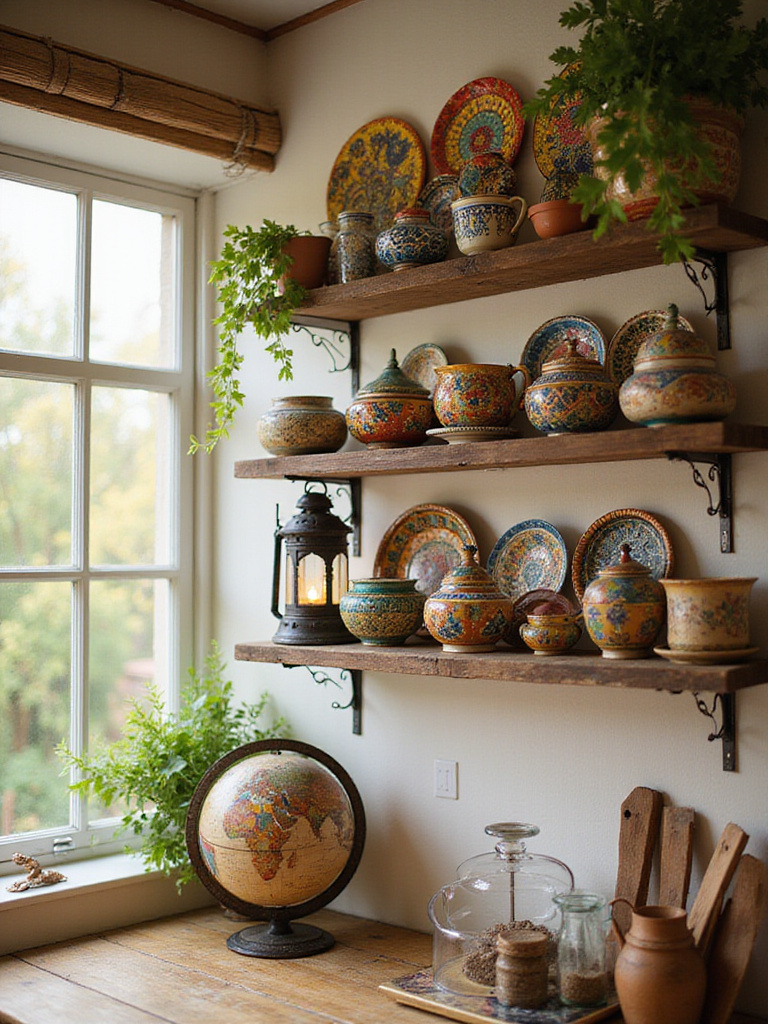
Choose materials and finishes that improve with age rather than showing wear as damage. Unlacquered metals develop character over time, while natural wood gains depth and richness through use. These living finishes create a sense of history and authenticity that perfectly manufactured items cannot replicate.
This approach extends to your arrangement and styling choices as well. Slightly askew artwork, casually draped textiles, and organically arranged collections feel more inviting and lived-in than perfectly aligned displays. The goal is creating a space that feels like it evolved naturally over time rather than being designed all at once.
The visual weight balances perfectly when you embrace the natural irregularities that make handmade and well-loved items so appealing.
18. Create Vertical Garden Displays
Maximizing growing space in a compact eclectic kitchen bohemian area requires thinking vertically and creatively about plant placement. Wall-mounted planters, hanging gardens, and tiered plant stands allow you to incorporate significant greenery without sacrificing precious counter or floor space. This approach also draws the eye upward, making your kitchen feel taller and more spacious.
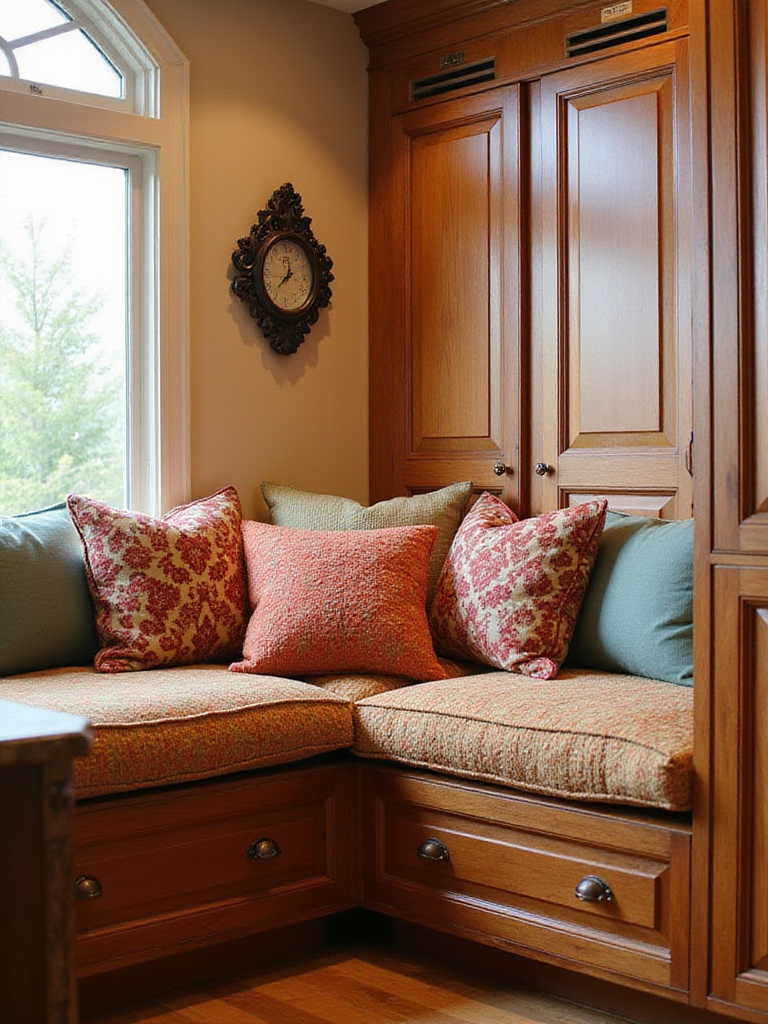
Consider creating a living wall using a variety of herbs and small plants in coordinating containers. This becomes both functional garden and living artwork, providing fresh ingredients while adding the natural beauty essential to bohemian style. Choose plants with different textures, colors, and growth habits to create visual interest throughout the seasons.
Trailing plants work particularly well in small kitchens because they add movement and softness without taking up floor space. Hang them from ceiling hooks, mount them on walls, or place them on high shelves where they can cascade downward, creating natural curtains of greenery.
The tactile experience changes the entire room’s energy as you brush against herbs while cooking or tend to your vertical garden during quiet morning moments.
19. Incorporate Global Market Finds
Building an authentic eclectic kitchen bohemian collection requires seeking out unique pieces from global markets, artisan fairs, and cultural festivals. These items bring stories and cultural connections that mass-produced decor simply cannot provide. Whether it’s hand-painted tiles from Morocco, carved wooden spoons from Kenya, or woven baskets from Guatemala, each piece adds layers of meaning to your space.

The key is choosing items that resonate personally with you rather than simply checking off cultural boxes. Perhaps you fell in love with the deep blue of Talavera pottery during a trip to Mexico, or discovered the perfect vintage brass tray at a local cultural festival. These personal connections make your collection feel authentic rather than appropriative.
Build your global collection gradually, allowing each trip or cultural experience to contribute something meaningful to your kitchen. This approach ensures your space tells your personal story while celebrating the diverse craftsmanship traditions that inspire bohemian design.
- Seek out authentic pieces from cultural festivals and artisan markets
- Choose items that tell personal stories of travel or cultural connection
- Mix different cultural influences thoughtfully and respectfully
- Focus on craftsmanship and quality over quantity
The cultural heritage preserved in each piece includes traditional techniques and artistic expressions that connect your kitchen to a broader world of creativity.
20. Design Flexible Storage Solutions
Small eclectic kitchen bohemian spaces require storage solutions that adapt to changing needs while maintaining aesthetic appeal. Woven baskets, vintage crates, and repurposed containers offer flexibility that built-in storage cannot match. These pieces can be rearranged, repurposed, and moved as your needs evolve, while adding the natural textures and organic shapes that define bohemian style.

Consider storage that serves multiple functions—a beautiful vintage trunk might store linens while providing extra seating, or a collection of ceramic crocks could hold utensils while creating an attractive countertop display. This approach maximizes functionality while ensuring every storage solution contributes to your overall aesthetic.
Open storage works particularly well in bohemian kitchens because it allows you to display beautiful items while keeping them accessible. Choose containers that are attractive enough to remain visible—glass jars for dry goods, woven baskets for produce, ceramic vessels for utensils—turning necessary storage into decorative elements.
The versatility reveals itself when you pair functional storage with beautiful materials and thoughtful placement that enhances rather than detracts from your overall design.
21. Mix Metals and Finishes Thoughtfully
While matchy-matchy metal finishes dominated kitchen design for years, the eclectic kitchen bohemian aesthetic celebrates the beauty of mixed metals when combined thoughtfully. The key is finding a common thread—perhaps all warm metals like brass, copper, and bronze, or varying finishes of the same base metal—that creates cohesion while allowing for interesting variety and visual texture.
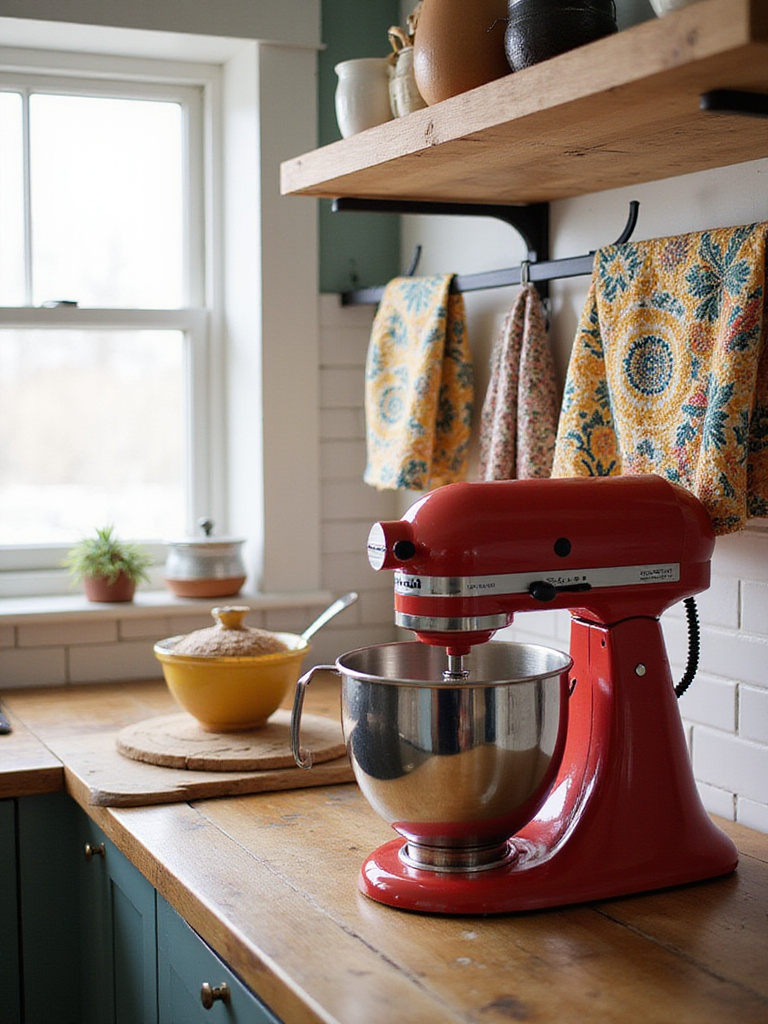
Consider the story each metal tells and how they work together to create your overall narrative. Aged brass suggests vintage European markets, while hammered copper evokes artisan workshops, and raw steel adds industrial edge. When combined carefully, these different metals create layers of history and cultural reference that enrich your space.
The patina and wear patterns that develop over time on mixed metals add to the authentic, collected-over-time feeling that’s essential to bohemian design. This natural aging process means your kitchen will continue evolving and developing character through daily use.
The finishing touch that elevates the entire look comes from embracing the natural variations and imperfections that make mixed metals so much more interesting than uniform finishes.
22. Create Seasonal Adaptability
An authentic eclectic kitchen bohemian space should feel connected to natural rhythms and seasonal changes, adapting its colors, textures, and accessories to reflect the time of year. This doesn’t require major overhauls—simple changes like swapping textile colors, adjusting plant selections, or rotating decorative objects can transform your kitchen’s mood while maintaining its core bohemian character.
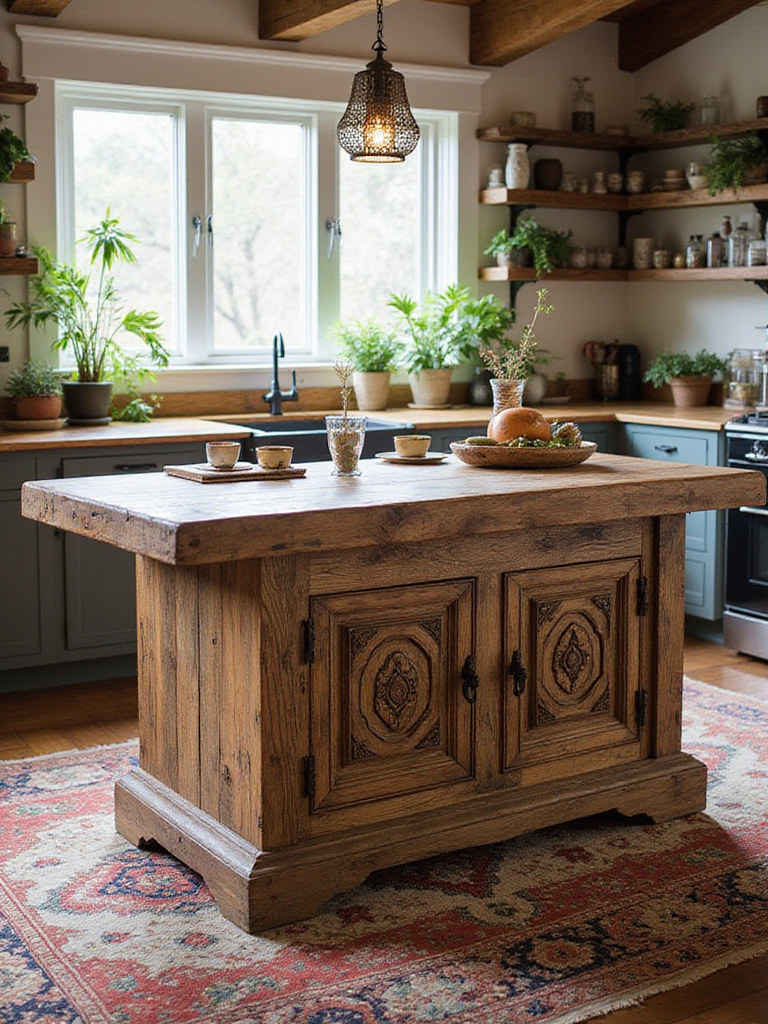
Summer might bring brighter textiles, fresh herbs, and lighter accessories, while winter calls for deeper colors, dried flowers, and cozy textures. This seasonal evolution keeps your space feeling fresh and connected to the natural world, preventing the stagnation that can occur when rooms never change.
Build flexibility into your design from the beginning by choosing neutral base elements that can support different seasonal accents. This approach allows you to experiment with trends and personal preferences without requiring major investments or renovations.
The forecast for next season already hints at how your evolving collection of textiles, plants, and accessories will create new combinations and fresh energy in your bohemian kitchen.
23. Incorporate Water and Natural Elements
The sound and movement of water add a sensory dimension that enhances the natural, peaceful feeling of an eclectic kitchen bohemian space. This might be as simple as a small tabletop fountain, a wall-mounted water feature, or even just the gentle bubble of a fish tank or aquarium garden. These elements bring life and movement while creating the soothing background sounds that make kitchens feel more relaxing.

Natural elements like stones, shells, driftwood, and crystals can be incorporated into your displays and arrangements to reinforce the connection to nature that’s fundamental to bohemian design. These items work particularly well in kitchens because they’re durable, easy to clean, and add interesting textures and colors to your collections.
Consider how these natural elements interact with light throughout the day—water creates dancing reflections, crystals cast rainbow patterns, and smooth stones provide grounding visual weight that balances more ornate decorative pieces.
The emotional response this evokes begins with the fundamental human connection to natural elements and the peace they bring to our daily environments.
24. Personalize with Meaningful Objects
The final layer of any successful eclectic kitchen bohemian design comes from incorporating objects that hold personal meaning and tell your unique story. These might be family heirlooms, travel souvenirs, gifts from friends, or pieces you’ve created yourself. The key is choosing items that spark joy and memories while contributing to your overall aesthetic vision.

These personal touches are what transform a well-designed space into a true home. A grandmother’s mixing bowl displayed on open shelving, a cutting board made by a local artisan friend, or pottery you created in a weekend class—these items add layers of meaning that no store-bought collection can replicate.
The beauty of bohemian design lies in its celebration of the personal and the imperfect. Your space should reflect your journey, your relationships, and your experiences in ways that feel authentic and unrepeatable. This personal curation is what makes each bohemian kitchen unique and prevents the style from feeling formulaic or trendy.
The maker’s journey from apprentice to master influenced every curve and detail, creating pieces that carry both artistic vision and personal history into your daily life.
Conclusion: Your Bohemian Kitchen Journey
Creating an eclectic kitchen bohemian space is ultimately about crafting a room that reflects your authentic self while maximizing the potential of your available space. Through thoughtful layering of textures, colors, and meaningful objects, even the smallest kitchen can become a vibrant hub that celebrates global influences, natural beauty, and personal history. The key lies in embracing the philosophy that imperfection and collected-over-time aesthetics create more soul than any perfectly coordinated design scheme.
Remember that building an authentic bohemian kitchen is a gradual process that should evolve with your life, travels, and changing needs. Start with one or two elements that speak to you—perhaps a collection of handmade ceramics or a vintage textile that catches your eye—and build from there. Each addition should feel intentional and meaningful, contributing to the overall story your kitchen tells about who you are and what you value.
Your eclectic kitchen bohemian space will become more than just a place to prepare meals; it will serve as a daily reminder of your creativity, your connections to global cultures, and your appreciation for the handmade and the authentic. Embrace the journey of creating this unique space, and allow it to grow and change as you do, always reflecting the beautiful complexity of a life well-lived.
